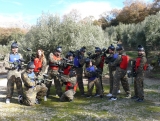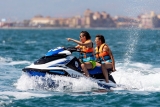As you might expect, you'll need to expand your standard diving kit with two light sources (a primary and backup torch), a chemical light, strobe lights to mark the exit point, and a compass. Wearing gloves is important to avoid potential cuts from rocks, as is thermal protection.

Lights
- The primary torch will be your main light source throughout the dive. Choose the most powerful option to fully enjoy the experience. Opt for canister torches over handheld ones - they should be at least 20 watts with a runtime exceeding 45 minutes. You'll have two torch options: rechargeable models (though more expensive, they pay for themselves quickly if you night dive regularly) or battery-powered alternatives.
- The backup torch comes into play when your primary light fails. While it doesn't need to be as powerful, it should provide enough illumination to find your way back.
- Chemical lights help your dive buddies locate you if your torches fail. When diving in a group, choose different colours to distinguish between the lead diver and the sweep. Remember these are positioning lights only, not for illumination, with a typical duration of about twelve hours.
- Strobe positioning lights will help you find your way back - place them on elevated points visible from your dive area. Good locations include the boat's anchor line, a prominent rock at the reef's exit point, or your planned water exit location.
Always carry an extra land torch for gearing up to avoid unnecessarily draining your dive lights.

The Compass
A compass becomes essential for night diving, especially if planning long traverses. Remember your visibility reduces to just a few metres, and natural navigation references practically disappear after dark.
Ideal Locations
For your first night dives, choose sheltered areas with minimal surge, currents and tidal changes. Shore diving (from coves with vehicle access for kit unloading) proves better than boat diving, particularly at sites where you've previously day-dived and can orient easily.
You don't need great depth to enjoy night diving. Always stay within no-decompression limits and avoid mandatory stops.
As you grow accustomed to darkness, you'll become more selective. Follow these location tips:

Wait two hours after sunset to dive - this allows nocturnal marine life to become fully active.
- Select rocky areas with abundant crevices - daytime creatures emerge to feed at night.
- Avoid featureless cliff walls - though teeming with life by day, these become biological deserts at night.
- Caves and wrecks offer dramatic day-night contrasts but aren't recommended due to disorientation risks.
- Sandy beaches deliver delightful surprises - seemingly barren by day, they transform into vibrant ecosystems after dark as buried creatures emerge.
Enjoy the phosphorescence created by hand or fin movements - this magical phenomenon comes from bioluminescent plankton (Noctiluca dinoflagellates). Your first sighting will feel... enchanting.
Dive Planning
While planning matters for day scuba diving, night diving demands particularly thorough preparation. Consider these specifics:

First, prefer full moon nights - moonlight significantly aids kit preparation and provides some orientation at shallow depths.
- Check all equipment, carrying spares and tools. You won't find dive shops open at 10pm if you discover regulator issues underwater.
- Verify all light sources have full batteries - nobody enjoys night diving completely in the dark.
- Carry at least double the lighting capacity relative to your planned dive duration.
- Position marker lights strategically to aid return navigation. When diving from a boat, ensure it displays proper position lights, that crew monitor you, and install additional return markers (e.g., at the anchor base and potential 3m safety stops).
- Review all hand signals with your team beforehand, including night-dive specific ones.
- Keep groups small - more than four divers becomes unwieldy.
- Check sea conditions, tides and currents - especially important for Atlantic or tropical tidal areas.
- Notify the relevant authority about your night dive - some military zones, reserves, ports or fishing areas prohibit diving.
- Strictly follow the rule of thirds for air consumption: one third out, one third back, one third reserve.
- Identify night-opening hospitals and medical centres in case of emergencies.
- Post-dive, verify you have all equipment.
Underwater, night diving differs mainly in reduced visibility limited to your torch beam - this easily causes disorientation when lights fail. These tips will help:

Torch Handling
- Never shine lights directly in other divers' eyes or sweep beams erratically.
- Always keep one light active so buddies can locate you.
- When diving from a boat, keep it on the horizon for reference.
- Enter water fully equipped (especially lights and buoyancy gear), checking for currents first.
- Upon descent, the dive leader should secure the boat's anchor and verify easy retrieval.
- Maintain good buoyancy to avoid bumping buddies or seabed - watch those fin kicks!
- During ascent, monitor your ascent rate via depth gauge or computer - visual references disappear.
- Avoid exhausting lights underwater - nobody fancies diving blind.
- Limit long swims - instead, focus on the fascinating microfauna that emerges at night. Inspect every inch!

Clearly, you can't simply jump in and try night diving. You'll need a specialised diving course where instructors will thoroughly prepare you while introducing the wonders of underwater "nightlife". Then you'll be more than ready!











